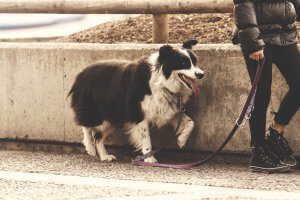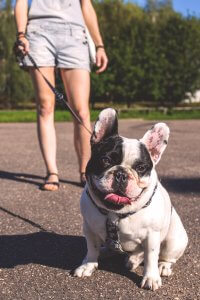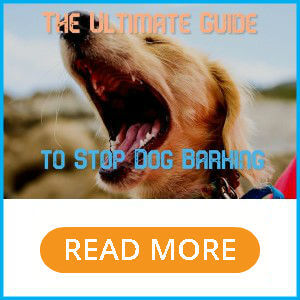
How many times have you been told exercise is good for your mind, body and soul?
We reckon you probably can’t count it. In fact, as humans, we get the notion of exercise hammered into our heads; it’s pretty much avoidable for our everyday lives. It’s something we have to do to stay fit and healthy.
This is no different for any other animal, except for dogs. As dog owners it’s our duty to make sure they have sufficient exercise.
It’s simple: a tired dog is a well-behaved dog.
No matter the breed, age, or size, every dog needs regular exercise to help maintain good mental and physical health. We know this is something you sign up for as a dog owner, but there’s more wisdom than you realize to exercising your dog. In fact, frequent exercise can benefit both you and your dog in many ways.
However, before we jump straight into the plus points, we need to reinforce for those you already, why exercise is vital.
Is it important to exercise your dog?
No dog is ever an exception from exercise; irrespective of their age, breed, size or ability, they must undergo daily exercise. There are many reasons behind this, but one of the most common ones is to control their behaviour.
If they exercise, they’re less likely to engage in boredom behaviours such as chewing and licking furniture in your home. This means you’re less likely to have to pay for furniture to get refurbished or purchase new ones altogether.
Similarly, dogs can get obese if not exercised regularly. Therefore if you exercise it daily, you’ll less likely have to deal with obesity, which can trigger more serious diseases and also vet bills will decrease as a result. Plus, it adds lubrication to their joints, reducing the risk of any mobility issues.
It also helps their self-esteem as a dog becomes more confident exploring new environments and boots their mental health due to socialization. Therefore reducing their risk of developing anxiety.
Finally, we wouldn’t say it’s important to exercise your dog; it’s pretty much essential. There are unlimited benefits to its physical, mental and social wellbeing. We say this because there’s so much up and coming as to why exercise is great for your dog. To know more, read on where we highlight more benefits.
Benefits of dog exercise:
- Stronger bond: When you take your canine for exercise, you’re experiencing bonding on a whole new level. Whether you’re walking, running, swimming or playing games, they will build a whole new level of trust with you. Plus, they will feel like you’re paying more attention to them, which adds to their emotional wellbeing.
- Encourages a healthy digestive system: Exercise helps your dog stick to their routine and go to the bathroom outside when they feel like it. This relieves any constipation and reduces their risk of bladder infections.
- Helps reduce or eliminate common behavioural problems: Your dog is less likely to engage in excessive barking, licking, chewing, digging, anxiety, and even aggression.
- Keeps your dog healthy and limber: This encourages the amount of fluid in your dog’s joints, allowing them to easily move and become less rigid.
- Great for your personal health: Sometimes it can be hard for us to exercise and we need a reason to. Your dog can be a great accountability partner and help you get your daily dose of endorphins in.
- Assists in build your dog’s confidence: Your dog is being exposed to new surroundings, new people and animals; this helps them get comfortable with the unfamiliar and allows them to become more confident.
- Helps keep your dog at a healthy weight: Frequent exercise will lower the chances of your dog getting obese and reduce the risk of life-threatening diseases from obesity such as pancreatitis, diabetes, heart disease, cancer, hypertension and more.
How do I know how much exercise my dog needs?
We can’t all be experts when it comes to exercising our dogs. Similarly, exercise is not a one size fits all approach for every breed. In fact, it can vary depending on their weight, age, sex and therefore, you should seek the help of a specialist like your vet.
A vet will be able to advise you about certain exercise programmes your dog can do and how much exercise they should be doing a day. Also, look out for Obesity signs in your dog; if you see them getting bigger, take them to your vet, who will be able to calculate their ideal body condition score. After all, approximately 54% of dogs are overweight or obese, and for most people, identifying your dog’s ideal body condition score can be challenging.
Not all signs that your dog is in need of a good walk will be obvious. Behaviours stemming from boredom or frustration [see ‘Benefits of exercising your dog’ above] are good indicators that your dog isn’t getting out enough. If your dog is pacing or wandering around the house, it could be another sign he is itching to get out.
On the other hand, if your dog is lounging on the couch and doesn’t wake when you move towards the door, his need for exercise may not be as great. However, this doesn’t mean he wouldn’t enjoy or benefit from going for a walk. If your dog continues to bring you a ball and beg for some attention even after an hour’s walk, they may not be getting the right type of exercise. At the end of the day, your dog should be happily tired. They should not be showing signs of stiffness or be so exhausted they don’t want to eat.
Do dogs need exercise every day?
You should never neglect your dog’s exercise, and that means not substituting it any day of the week for something else. While we humans can live a busy lifestyle, we know we can pick up where we left off. For dogs, though, they work well with routines, and them skipping exercise can mess up their emotional and mental wellbeing.
Plus, exercising every day will help tone their muscles, stimulate their metabolism and prevent them from suffering from boredom. However, you can also stick to one routine like walking if you like. You might be thinking, is walking your dog every day healthy? Well, it is! If you stick to this workout, dogs can have better cardiovascular endurance, stronger bones, muscles, less stress and lower blood pressure.
It’s important to know that while every dog requires daily exercise, not every breed needs to undergo the same intensity as they did the day before. Similarly to prevent boredom we recommend switching up the type of exercise they do from time to time.
What type of exercise is best for my dog?
Exercise for your dog can come in many different forms. Experiment and choose a form of exercise that suits your dog’s interests and abilities, as well as your own.
- On-leash walks: Offer a structured exercise that is often enough for smaller dogs or brachycephalic breeds (short or flat-faced dogs such as pugs or bulldogs).
- Off-leash walks: Allow your dog to go at their own pace, to run, sniffing, or playing as they need.
- Swimming: A great way to burn that excess energy. Keep in mind; water isn’t for every dog.
- Fetch: If you have a ball-oriented dog, they can have hours of focused fun on nothing but the game. This is a great way to burn a lot of energy in a small space or with limited time.
- Dog sports Are group/class activities such as agility, flyball, rally-o, or lure chasing. These are another great way to get your dog out a couple of times a week
- Running or biking: Most dogs are bred for short, fast bursts of running, not necessarily for running a marathon. Be sure you are listening to your dog when they show signs of slowing down.
- Exercising their brain instead of their body: Working a dog’s brain is another way to stimulate them and can be as simple as feeding them from a puzzle dish or giving them a stuffed Kong.
- Training: Another way to tire them out. Working on their recall or teaching them a new trick will stimulate them both mentally and physically.

How to exercise your dog at home?
If you can’t get out to take your dog to the local park, there are some great exercises you can do from home. First of all, if there are other people in your home, you could get your housemates or family members involved and play hide and seek!
Second, you could run up and down your stairs. Doing this will not only get your dog into shape but will also increase your fitness levels too! You could also play tug of war, play hide and seek with treats, fetch and much more. The opportunities are endless; you just need to get creative!
What if I can’t get my dog the exercise they need?
Pets are our pride and joy; they’re our family members, our babies. Whenever we can, we want to do what’s right and the best for them. But we know as humans, we also lead busy lives and cannot always be there.
Luckily, the professional pet care industry has expanded greatly in the last couple of years. Professional dog walkers are available to help your dog get the exercise and attention they need while you are at work. The right amount of exercise will help prevent health complications and expenses further down the road. Although you might feel the added expense is more than you can justify, if it ensures that your dog gets the exercise they need to lead a healthy, happy life, it is worth it.




